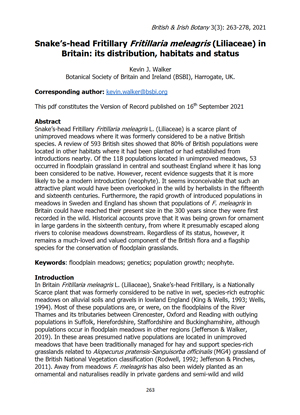NEWS 2021
Snake’s-head Fritillary Fritillaria meleagris (Liliaceae) in Britain: its distribution, habitats and status
Kevin J WALKER
British & Irish Botany 3(3): 263-278 (2021)
https://doi.org/10.33928/bib.2021.03.263
Botanical Society of Britain and Ireland (BSBI), Harrogate, UK
Abstract
Snake’s-head Fritillary Fritillaria meleagris L. (Liliaceae) is a scarce plant of unimproved meadows where it was formerly considered to be a native British species. A review of 593 British sites showed that 80% of British populations were located in other habitats where it had been planted or had established from introductions nearby. Of the 118 populations located in unimproved meadows, 53 occurred in floodplain grassland in central and southeast England where it has long been considered to be native. However, recent evidence suggests that it is more likely to be a modern introduction (neophyte). It seems inconceivable that such an attractive plant would have been overlooked in the wild by herbalists in the fifteenth and sixteenth centuries. Furthermore, the rapid growth of introduced populations in meadows in Sweden and England has shown that populations of F. meleagris in Britain could have reached their present size in the 300 years since they were first recorded in the wild. Historical accounts prove that it was being grown for ornament in large gardens in the sixteenth century, from where it presumably escaped along rivers to colonise meadows downstream. Regardless of its status, however, it remains a much-loved and valued component of the British flora and a flagship species for the conservation of floodplain grasslands.




